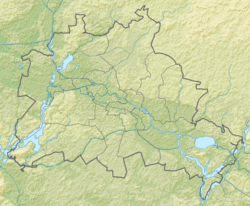
The House of Hohenzollern is a formerly royal German dynasty whose members were variously princes, electors, kings and emperors of Hohenzollern, Brandenburg, Prussia, the German Empire, and Romania. The family came from the area around the town of Hechingen in Swabia during the late 11th century and took their name from Hohenzollern Castle. The first ancestors of the Hohenzollerns were mentioned in 1061.

Potsdam is the capital and largest city of the German state of Brandenburg. It is part of the Berlin/Brandenburg Metropolitan Region. Potsdam sits on the River Havel, a tributary of the Elbe, downstream of Berlin, and lies embedded in a hilly morainic landscape dotted with many lakes, around 20 of which are located within Potsdam's city limits. It lies some 25 kilometres southwest of Berlin's city centre. The name of the city and of many of its boroughs are of Slavic origin.

Wannsee is a locality in the southwestern Berlin borough of Steglitz-Zehlendorf, Germany. It is the westernmost locality of Berlin. In the quarter there are two lakes, the larger Großer Wannsee and the Kleiner Wannsee, located on the River Havel and separated only by the Wannsee Bridge. The larger of the two lakes covers an area of 2.7 km2 (1.0 sq mi) and has a maximum depth of 9 m (30 ft).
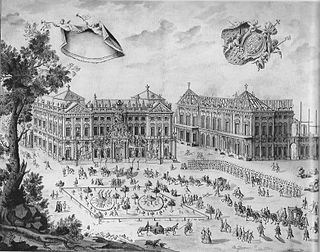
Residenz is a German word for "domicile", now obsolete except in the formal sense of an official residence. A related term, Residenzstadt, denotes a city where a sovereign ruler resided, and thus carries a similar meaning to the contemporary expressions seat of government or capital. As there were many sovereign rulers in the Holy Roman Empire, ranking from lord (Herr) to prince elector and king, there are many cities, palaces, and castles in the empire's former territory which used to be a Residenz, some of which are still so referred to today. The former status of a city as a Residenz is frequently reflected in the architecture of its center. During the baroque period especially, many prestigious buildings were erected; sometimes even new towns were founded. Most former Residenzstädte still serve as cultural and administrative centers today.

Heinrich Ludwig Ferdinand von Arnim was a German architect and watercolour-painter. He was a student of Karl Friedrich Schinkel and mainly worked in Berlin and Potsdam.

Friedrich Ludwig Persius was a Prussian architect and a student of Karl Friedrich Schinkel.
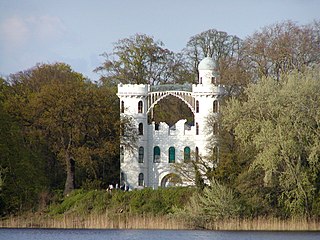
Pfaueninsel is an island in the River Havel situated in Berlin-Wannsee, in the district of Steglitz-Zehlendorf in southwestern Berlin, near the border with Potsdam in Brandenburg. The island is part of the Palaces and Parks of Potsdam and Berlin UNESCO World Heritage Site because of its outstanding Prussian architecture and is a popular destination for day-trippers. Pfaueninsel is also a nature reserve in accordance with the EU Habitats Directive and a Special Protection Area for wild birds.

Peter Joseph Lenné was a Prussian gardener and landscape architect. As director general of the Royal Prussian palaces and parks in Potsdam and Berlin, his work shaped the development of 19th-century German garden design in the Neoclassical style. Laid out according to the principles of the English landscape garden, his parks are now World Heritage Sites.

Glienicke Palace is a historic palace located on the peninsula of Berlin-Wannsee in Germany. It was designed by Karl Friedrich Schinkel around 1825 for Prince Carl of Prussia. Since 1990, Glienicke Palace and the park have been part of the UNESCO World Heritage Site "Palaces and Parks of Potsdam and Berlin" because of their unique contribution to Prussian landscape architecture.
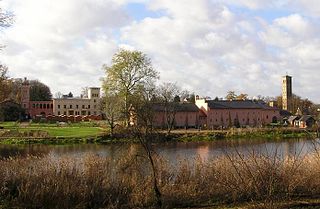
Bornstedt is a borough of Potsdam, Germany. Located north of Sanssouci Park and the Orangery Palace, it is known for the Bornstedt Crown Estate, former residence of Princess Royal Victoria, and the Bornstedt Cemetery with numerous tombs of famous personages.

Palaces and Parks of Potsdam and Berlin are a group of palace complexes and extended landscaped gardens located in the Havelland region around Potsdam and the German capital of Berlin. The term was used upon the designation of the cultural ensemble as a World Heritage Site by UNESCO in 1990. It was recognized for the historic unity of its landscape—a unique example of landscape design against the background of monarchic ideas of the Prussian state and common efforts of emancipation.

Schloss Köpenick is a Baroque water palace of the Hohenzollern electors of Brandenburg which stands on an island in the Dahme River surrounded by an English-style park and gives its name to Köpenick, a district of Berlin.

A Jagdschloss is a hunting lodge in German-speaking countries. It is a schloss set in a wildlife park or a hunting area that served primarily as accommodation for a ruler or aristocrat and his entourage while hunting in the area.

Prince Joachim Viktor Wilhelm Leopold Friedrich Sigismund of Prussia was a German World War I fighter pilot and member of the House of Hohenzollern as the son of Prince Friedrich Leopold of Prussia and Princess Louise Sophie of Schleswig-Holstein-Sonderburg-Augustenburg.

Babelsberg Park is a 114 hectare park in the northeast of the city of Potsdam, bordering on the Tiefen See lake on the River Havel. The park was first designed by the landscape artist Peter Joseph Lenné and, after him, by Prince Hermann von Pückler-Muskau and Karl Friedrich Schinkel, by order of the then-prince William I and his wife, Augusta. Located on a hill sloping down to the lake, the park and castle are part of the Palaces and Parks of Potsdam and Berlin, which were inscribed on the UNESCO World Heritage List because of their unique architecture and testimony to the development of landscape design.

Park Glienicke, is an English landscape garden in the southwestern outskirts of Berlin, Germany. It is located in the locality of Wannsee in the Steglitz-Zehlendorf borough. Close to Glienicke Bridge the park is open to the general public. The park is part of the UNESCO World Heritage Site Palaces and Parks of Potsdam and Berlin. Within the ensemble it is one of the five main parks, the others being Sanssouci Park, New Garden, Babelsberg Park and Peacock Island (Pfaueninsel). Regarding diversity in gardening styles within the Potsdam park ensemble Park Glienicke is only superseded by Sanssouci Park. Furthermore, it is a park especially characterized by one personality due to the intense involvement of Prince Charles of Prussia. The park covers approximately 116 hectares

The Jagdschloss Grunewald, a hunting lodge, is the oldest preserved castle of Berlin, Germany. It is on the south waterfront of the Grunewaldsee and is part of the locality Dahlem in the borough Steglitz-Zehlendorf.
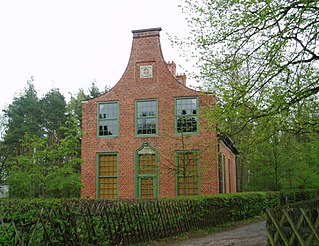
The Stern Hunting Lodge in Potsdam was built between 1730 and 1732 under the reign of the Soldier King Frederick William I in the style of a simple Dutch town house. The contract for the construction was probably awarded to Cornelius van den Bosch, a grenadier and master carpenter from Holland, and the building was supervised by Pierre de Gayette, Captain of the Corps of Engineers and Court Architect.

